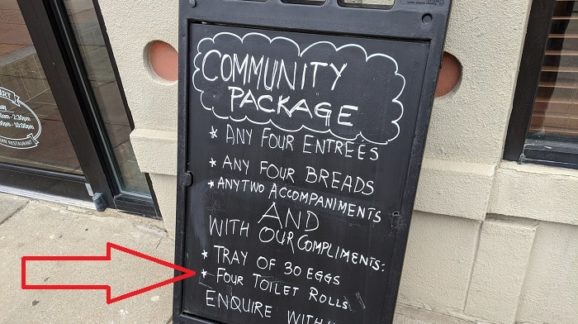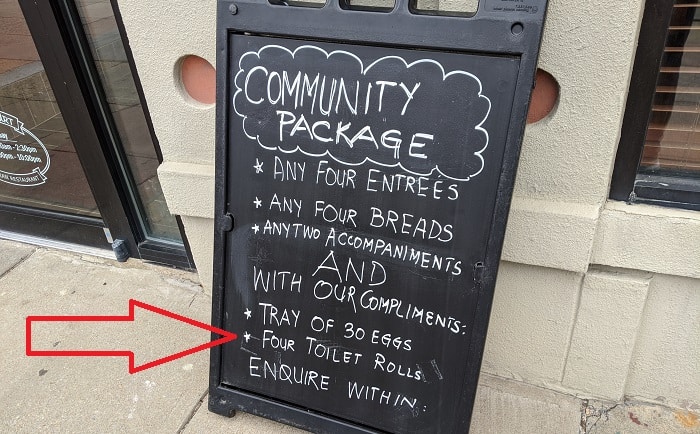Pandemic Economy: Toilet Paper Supplies Stretched, But Strong

American consumers, worried about the future of the coronavirus pandemic and concerned about facing potentially long periods of quarantine, have continued to buy out available stocks of key products like hand sanitizer, antibacterial wipes, and—of course—toilet paper. As I wrote earlier this month, however, temporary shortages of a few extremely high-demand items are the exception that proves the rule: the American consumer economy is doing an extremely good job under extraordinary stress, and we have a decentralized market economy to thank for that.
Much in the way that the current novel coronavirus crisis has been very different from previous communicable disease epidemics, the current shortage of supplies like toilet paper is quite different from the usual reasons we see temporarily empty store shelves. Most commonly, we see panic buying of key supplies related to weather emergencies like blizzards and hurricanes. In those cases, there is a relatively short time span during which demand spikes, starting when weather forecasters confirm that such an event is likely on the way, through the next few days before it arrives. Once a major event begins playing out, demand at stores goes back to zero, because they’re rendered inaccessible for the duration.
Our current situation is quite different, in that the emergency that people are trying to supply themselves for is now stretching over several weeks, with no obvious end in sight. Normally that would make scarcity problems much worse—imagine a white-out blizzard hitting Chicago and lasting for three months—but fortunately COVID-19 infections have not significantly reduced production and delivery capacity. All of our supermarkets and drugstores are as accessible as ever.
America’s toilet paper factories are working 24 hours a day, and we fortunately still have plenty of healthy truck drivers who are delivering the product around the country. Retail supplies are also benefiting from significantly reduced commercial demand, as far fewer rolls are needed for now-empty offices, hotels, conference centers, airports, and restaurants. But because the uncertainty about the duration of the pandemic continues, new supplies are being snapped up as quickly as they are restocked.
Retailers around the country are responding in a variety of ways, including instituting per-customer limits on purchases. Some stores are not restocking their normal shelves, but informing customers that they have to request certain products directly from staff, lest anxious shoppers rake entire shelves of product. The Target at 4500 Wisconsin Avenue NW in Washington, D.C. has signs warning customers that they are “limiting the quantities of toilet paper, flushable wipes, and facial tissue to 1 each per guest.” The Whole Foods across the street has announced that “to support all customers,” the store is enforcing limits on baby formula, liquid bleach, and diapers as well. The CVS on the same block has even decided to use the shortage as a marketing opportunity, marking the bottom of its paper product shelves (normally covered with inventory) with stickers suggesting that customers try their “Total Home” store brand if their usual brand is out of stock.
Humans being the creative creatures that they are, we’re also seeing a number of funny and unexpected responses to these temporary supply issues. London-based software developer Ben Sassoon and artist Sam Harris developed the website howmuchtoiletpaper.com to help people gauge how much they might need during a period of self-isolation. According to the site, “The average user has 500% more toilet paper than they need for quarantine,” which should help horde-prone people everywhere realize they probably don’t need as much as they thought they did. For those who actually are running low, Katie Conner at CNET has suggestions on how to get notified when retailers are back in stock.
Some foodservice businesses are also offering take-out specials that help them use up their own inventory that they no longer need with an empty dining room. Looking around my own neighborhood in D.C., Indian restaurant Masala Art is offering a “community package” consisting of several menu items, a tray of fresh eggs, and four rolls of toilet paper.

Local D.C. restauranteur Geoff Tracy has set up a “neighborhood pantry” at his New Mexico Avenue location with his store’s supplies, including milk, dry pasta, latex gloves, and single rolls of toilet paper ($1 each). All proceeds are going to his temporarily unemployed staff. Reporter Nick Rallo also wrote up this trend yesterday for the Dallas Morning News with the headline “Need toilet paper? Restaurants are evolving into general stores, offering eggs, meat and other grocery essentials.”
Finally, several Costco and Walmart locations are sending one of the more encouraging market signals we’ve seen recently by announcing that they will not accept returns of products like toilet paper, paper towels, sanitizing wipes, and bottled water. Hopefully that means that the first wave of panic buyers are already feeling the remorse and have tried to trade their hordes in for cash. In any case, it will make some customers think twice before buying 400 rolls on the assumption that they can just return it all when things go back to normal.
UPDATE: After this post was published, Will Oremus published “What Everyone’s Getting Wrong About the Toilet Paper Shortage” on Medium. He points out that, while some institutional toilet paper supplies can likely be re-directed to the retail public, the two products have different supply chains, and in some cases aren’t physically compatible (some of it “comes in huge rolls, too big to fit on most home dispensers.”). That doesn’t change the fact that the market economy is generally reacting well to the coronavirus pandemic supply crunch, but does complicate reaching a new equilibrium in this particular product category.